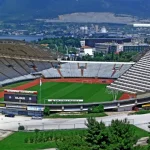September 12, 2019 – Poljud Stadium, one of Split’s most famous landmarks and the home of football club Hajduk Split, opened exactly 40 years ago today for the VIII Mediterranean Games in 1979.
24 Sata reports that Poljud Stadium was built following the project of prominent Croatian architect Boris Magas in 1979 for the needs of the VIII Mediterranean Games, after which it became the home of Hajduk Split. The stadium, known as “The Poljud Beauty”, is interesting because of its architectural composition – its seashell-like design gives views of the nearby hills, sea, and islands, and was modeled after ancient Greek theaters.
The first football match at Poljud was played three days after the opening, but the attendance record was set in 1982 when there were between 55,000 to 60,000 people at the Split stadium. However, since there was no counter at the time, the exact number is based on speculation. The official capacity of Poljud is about 35,000 people.
Numerous sports and other events have taken place at Poljud, which are still held today. From the games of Hajduk to the Croatia national team, music festivals like Ultra, and concerts of Croatian singers, this building has seen it all.
https://www.youtube.com/watch?v=v=b3LP-OVOFBQ
Unfortunately, architect Boris Magas died in 2013, though some six years later, Hajduk hosted his grandson Bartol Pavusek and thanked him for his work and the efforts of his grandfather.
Although it is still one of the most beautiful stadiums in Croatia, many problems plague the ‘Poljud beauty’.
At the time of its construction, Poljud’s comfort, unique roof structure and appearance was unsurpassed even in Europe, and because of this, in 2015, it was included in the list of protected cultural assets of the Republic of Croatia. However, the passing of time and poor maintenance have left their mark.
Some say that Poljud’s roof structure is on the verge of collapsing, which resulted in various suggestions, one of them being that instead of the existing Lexan panels, solar panels would be set up to generate electricity and collect rainwater to irrigate the pitch. The investment would pay off in 10-15 years, but, as usual, paperwork and money got in the way.
In the last few years, Hajduk has made several interventions on rehabilitating and maintaining Poljud, with an investment of almost 40 million kuna. In 2019, a traffic light was repaired, in 2018, the damaged pitch from Ultra was changed, and two auxiliary terrains were built. A year earlier, the dressing rooms and all the facilities, such as the gym, first aid room, and fitness room were updated. Previously, the main pitch was drained and irrigated, and counters, barriers, and video surveillance were introduced.
https://www.youtube.com/watch?v=v=HP1SlkM7T_U
You can visit Poljud next to see Hajduk face Inter Zapresic and Varazdin, or wait until October for the highly anticipated Euro 2020 qualifier between the Croatia national team and Hungary.
To read more about sport in Croatia, follow TCN’s dedicated page.









